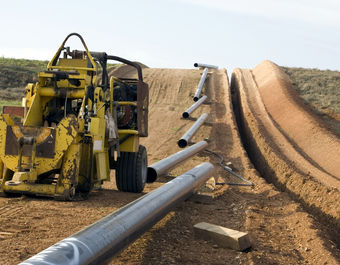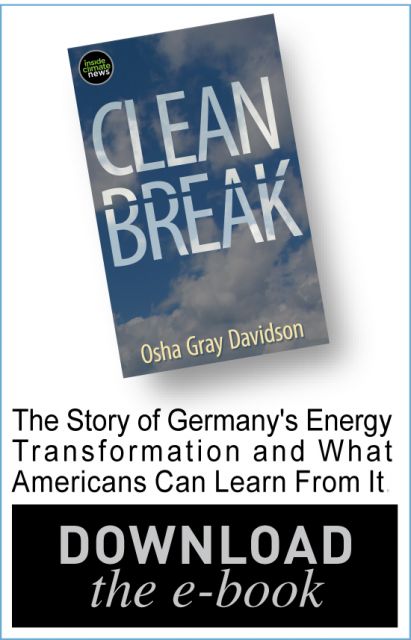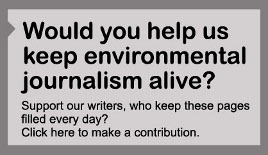Most Viewed Stories
Clean Economy News
Keystone XL Pipeline Safety Standards Not as Rigorous as They Seem

WASHINGTON—TransCanada and the U.S. State Department have repeatedly touted safety standards for the proposed Keystone XL heavy crude pipeline as robust and unparalleled. As proof, they point to 57 "special conditions" that the Alberta-based pipeline operator has agreed to follow.
But environmental watchdogs counter that those much-boasted-about claims are based on nothing more than smoke and mirrors. And they have compiled evidence to back up their accusations.
According to recent research by the Natural Resources Defense Council, only 12 of the 57 conditions set by federal regulators at the Department of Transportation differ in any way at all from the minimum standards the DOT routinely requires for pipeline safety. NRDC is an advocacy organization intent on halting construction of the pipeline.
"Many of these safety conditions are just restating current regulations," said Anthony Swift, the NRDC energy analyst responsible for the point-by-point study. "But they've been used as the cornerstone in the argument that we don’t need to worry about Keystone XL because these 57 conditions will solve any unknown safety risk that the pipeline poses."
The DOT's Pipeline and Hazardous Materials Safety Administration is responsible for overseeing hazardous liquid pipelines and enforcing safety measures. PHMSA began drawing up the list of conditions back in 2009 when TransCanada applied for a Keystone XL safety waiver. The company dropped its request for that waiver in August 2010 but announced in April that it would voluntarily comply with PHMSA's 57 conditions.
These precautionary measures are supposed to address pipeline safety concerns such as puncture resistance, inspections, and welding and construction standards. Both PHMSA and TransCanada said that's exactly what they do.
The 57 safety conditions the company agreed to with PHMSA are "above and beyond the industry norm," TransCanada spokesman Terry Cunha told InsideClimate News.
PHMSA spokesman Damon Hill said the list of conditions contains "requirements more stringent than existing regulations," adding that they "will increase safety from manufacture through operation of the pipeline."
The $7 billion Keystone XL, now under review by the State Department, would carry oil 1,702 miles from Canada to refineries along the U.S. Gulf Coast. It could deliver up to 900,000 barrels of heavy crude daily.
Inside the Analysis
As part of its analysis of the 57 conditions, the NRDC sorted them into four categories rated by how much difference each would make.
Swift said the dozen that improve upon existing minimum federal standards range from minor to substantive. They include burying the pipeline six to 12 inches deeper than required; assuring that the pipeline is puncture-resistant under pressure; lengthening the time devoted to pressure tests; validating data provided by the leak detection system; bumping up the number of shutdown valves from 104 to 106; providing PHMSA with construction plans, and agreeing to notify PHMSA when spills are reported to the federal government’s National Response Center.
Many of the remaining 45 conditions restate current regulations, Swift said, some repeated word for word. Others, including one requiring the pipeline to be inspected 26 times a year and another requiring tests to prevent the use of defective steel, duplicate minimum standards that TransCanada must comply with via PHMSA or duplicate basic legal safety standards. Five of the conditions detail how TransCanada should keep records and report to PHMSA its progress on complying with each standard.
"Rewording a standard doesn't mean it's updated," Swift said. "And it doesn’t mean a pipeline is stronger or safer."
As an example of the semantics he encountered during his analysis, Swift pointed to a current federal regulation that covers the inspection of rights-of-way and crossings under navigable waters. It reads: "Each operator shall, at intervals not exceeding 3 weeks, but at least 26 times each calendar year, inspect the surface conditions on or adjacent to each pipeline right-of-way. Methods of inspection include walking, driving, flying or other appropriate means of traversing the right-of-way.”
The Keystone XL special condition pertaining to pipeline patrolling reads this way: "Patrol the right-of-way at intervals not exceeding three (3) weeks, but at least twenty-six (26) times each calendar year, to inspect for excavation activities, ground movement, unstable soil, washouts, leakage, or other activities or conditions affecting the safety operation of the pipeline."
In its final environmental analysis, the State Department noted that the difference between the two is that the original regulation is "less prescriptive on items to look for during survey."
That explanation left Swift scratching his head.
"This is one of the many examples of the State Department and TransCanada playing a shell game to avoid addressing the legitimate safety concerns that the American public has with the Keystone XL," Swift said.
- 1
- 2
- 3
- next page »













